Given the following two tables (in SQL Server):
Employee:
CREATE TABLE Employee(Id int not null Identity(1,1),
FirstName varchar(50),
LastName varchar(50),
CONSTRAINT PK_Employee_Id Primary Key(Id));
Asset:
CREATE TABLE Asset(Id int Identity(1,1),
Manufacturer varchar(50),
Model varchar(50),
Description varchar(50),
Category varchar(25),
Comments varchar(150),
EmployeeId int,
CONSTRAINT PK_Asset_Id Primary Key(Id),
Constraint FK_Asset_EmployeeId_Employee_Id Foreign Key(EmployeeId) references Employee(Id))"
Try the following:
Add the following using directives:
using System.Configuration;using System.Data;using System.Data.SqlClient;using System.Diagnostics;
App.config:
<?xml version="1.0" encoding="utf-8" ?>
<configuration>
<connectionStrings>
<add name="ConnectionStringWindowsAuth" connectionString="Data Source=.\SQLEXPRESS;Database=HR;Integrated Security=True;Connect Timeout=30;Encrypt=False;TrustServerCertificate=False" providerName="System.Data.SqlClient" />
<add name="ConnectionStringWindowsAuthMars" connectionString="Data Source=.\SQLEXPRESS;Database=HR;Integrated Security=True;Connect Timeout=30;Encrypt=False;TrustServerCertificate=False;MultipleActiveResultSets=True" providerName="System.Data.SqlClient" />
<add name="ConnectionStringSqlServerAuth" connectionString="Server=.\SQLExpress;Database=HR;User Id=testUser;Password=mySuperSecretPassword;" />
<add name="ConnectionStringSqlServerAuthMars" connectionString="Server=.\SQLExpress;Database=HR;User Id=testUser;Password=mySuperSecretPassword;MultipleActiveResultSets=True" />
</connectionStrings>
<startup>
<supportedRuntime version="v4.0" sku=".NETFramework,Version=v4.8" />
</startup>
</configuration>
GetData:
private string _connectionStr = ConfigurationManager.ConnectionStrings["ConnectionStringSqlServerAuth"].ConnectionString;
private string _connectionStrMars = ConfigurationManager.ConnectionStrings["ConnectionStringSqlServerAuthMars"].ConnectionString;
public DataSet GetData()
{
//create new instance
DataSet ds = new DataSet();
using (SqlConnection con = new SqlConnection(_connectionStr))
{
using (SqlDataAdapter da = new SqlDataAdapter())
{
da.SelectCommand = new SqlCommand("SELECT * FROM Employee", con);
DataTable dtEmployee = new DataTable("Employee");
da.Fill(dtEmployee);
//add
ds.Tables.Add(dtEmployee);
da.SelectCommand = new SqlCommand("SELECT * FROM Asset", con);
DataTable dtAsset = new DataTable("Asset");
da.Fill(dtAsset);
//add
ds.Tables.Add(dtAsset);
foreach (DataTable dt in ds.Tables)
{
Debug.WriteLine($"dt[{dt.TableName}] row count: {dt.Rows.Count}");
foreach (DataColumn col in dt.Columns)
{
Debug.WriteLine($" ColumnName: {col.ColumnName}");
}
Debug.Write(Environment.NewLine);
}
}
return ds;
}
}
Update:
But are Table, Table1, Table2 and so on guaranteed?
According to Populating a DataSet from a DataAdapter, it states:
Multiple Result Sets
If the DataAdapter encounters multiple result sets, it creates
multiple tables in the DataSet. The tables are given an incremental
default name of TableN, starting with "Table" for Table0. If a table
name is passed as an argument to the Fill method, the tables are given
an incremental default name of TableNameN, starting with "TableName"
for TableName0.
Let's add some sample data:
Employee:

Asset:

If we execute the following code:
//Note: This doesn't work correctly
public DataSet GetData()
{
//create new instance
DataSet ds = new DataSet();
using (SqlConnection con = new SqlConnection(_connectionStr))
{
//open
con.Open();
using (SqlDataAdapter da = new SqlDataAdapter())
{
//1st query
da.SelectCommand = new SqlCommand("SELECT * FROM Employee", con);
da.Fill(ds);
foreach (DataTable dt in ds.Tables)
{
Debug.WriteLine($"dt[{dt.TableName}] row count: {dt.Rows.Count}{Environment.NewLine}");
foreach (DataColumn col in dt.Columns)
{
Debug.WriteLine($" ColumnName: {col.ColumnName}");
}
}
//2nd query
da.SelectCommand = new SqlCommand("SELECT * FROM Asset", con);
da.Fill(ds);
Debug.Write(Environment.NewLine);
foreach (DataTable dt in ds.Tables)
{
Debug.WriteLine($"dt[{dt.TableName}] row count: {dt.Rows.Count}{Environment.NewLine}");
foreach (DataColumn col in dt.Columns)
{
Debug.WriteLine($" ColumnName: {col.ColumnName}");
}
}
}
return ds;
}
}
The output is:
dt[Table] row count: 3
ColumnName: Id
ColumnName: FirstName
ColumnName: LastName
dt[Table] row count: 7
ColumnName: Id
ColumnName: FirstName
ColumnName: LastName
ColumnName: Manufacturer
ColumnName: Model
ColumnName: Description
ColumnName: Category
ColumnName: Comments
ColumnName: EmployeeId
As you can see, the table name is Table, in both the 1st and 2nd query. Additionally, the column names from the 2nd query were added to the table (name: "Table") in the DataSet. The final result is a table with 3 + 4 = 7 rows. This isn't the desired result.
Let's try with multiple result sets (ie: more than one select statement within a single SelectCommand). We'll use 2 select queries separated by semi-colon: SELECT * FROM Employee; SELECT * FROM Asset;
public DataSet GetDataMultipleResultSets()
{
//create new instance
DataSet ds = new DataSet();
//'Open' is explicitly called; the connection will be opened implicitly
using (SqlConnection con = new SqlConnection(_connectionStr))
{
using (SqlDataAdapter da = new SqlDataAdapter())
{
da.SelectCommand = new SqlCommand("SELECT * FROM Employee; SELECT * FROM Asset;", con);
da.Fill(ds);
foreach (DataTable dt in ds.Tables)
{
Debug.WriteLine($"dt[{dt.TableName}] row count: {dt.Rows.Count}");
foreach (DataColumn col in dt.Columns)
{
Debug.WriteLine($" ColumnName: {col.ColumnName}");
}
Debug.Write(Environment.NewLine);
}
}
return ds;
}
}
The output is:
dt[Table] row count: 3
ColumnName: Id
ColumnName: FirstName
ColumnName: LastName
dt[Table1] row count: 4
ColumnName: Id
ColumnName: Manufacturer
ColumnName: Model
ColumnName: Description
ColumnName: Category
ColumnName: Comments
ColumnName: EmployeeId
This is one gives the desired result, however as stated in the documentation the table names are Table and Table1.
If one desires for each DataTable within a DataSet to have the same name as the table within the database, one can use DataAdapter.TableMappings as shown below:
public DataSet GetDataMultipleResultSets()
{
//create new instance
DataSet ds = new DataSet();
//'Open' is explicitly called; the connection will be opened implicitly
//using (SqlConnection con = new SqlConnection(_connectionStrMars))
using (SqlConnection con = new SqlConnection(_connectionStr))
{
using (SqlDataAdapter da = new SqlDataAdapter())
{
//DataSet tables names are 'Table' (ie: Table0), 'Table1', 'Table2', 'Table3', etc...
//which is determined by the number of queries one specifies within a SelectCommand
da.SelectCommand = new SqlCommand("SELECT * FROM Employee; SELECT * FROM Asset;", con);
//since we have 2 select statements,
//the table names in the DataSet will be 'Table' and 'Table1'
//if we had 3 select statements,
//the table names in the DataSet would be 'Table', 'Table1', and 'Table2'
da.TableMappings.Add("Table", "Employee");
da.TableMappings.Add("Table1", "Asset");
da.Fill(ds);
foreach (DataTable dt in ds.Tables)
{
Debug.WriteLine($"dt[{dt.TableName}] row count: {dt.Rows.Count}");
foreach (DataColumn col in dt.Columns)
{
Debug.WriteLine($" ColumnName: {col.ColumnName}");
}
Debug.Write(Environment.NewLine);
}
}
return ds;
}
}
The output is:
dt[Employee] row count: 3
ColumnName: Id
ColumnName: FirstName
ColumnName: LastName
dt[Asset] row count: 4
ColumnName: Id
ColumnName: Manufacturer
ColumnName: Model
ColumnName: Description
ColumnName: Category
ColumnName: Comments
ColumnName: EmployeeId
Notice that for each DataTable within the DataSet, that the name now matches the name of table in the database (Employee and Asset).
Summary:
Given:
SqlConnection con = new SqlConnection(_connectionStr)SqlDataAdapter da = new SqlDataAdapter()
As demonstrated above, for a single result set (ie: a single select statement within a SelectCommand),
da.SelectCommand = new SqlCommand("SELECT * FROM Employee;", con);
da.Fill(ds);
or
da.SelectCommand = new SqlCommand("SELECT * FROM Asset;", con);
da.Fill(ds);
the result is the (default) DataTable name Table.
If one uses multiple result sets (ie: multiple select statements within a SelectCommand),
da.SelectCommand = new SqlCommand("SELECT * FROM Employee; SELECT * FROM Asset;", con);
da.Fill(ds);
the result is the (default) DataTable names Table, Table1, etc.., unless one adds a mapping using DataAdapter.TableMappings.
Resources:
Additional Resources:

